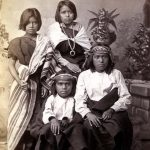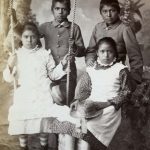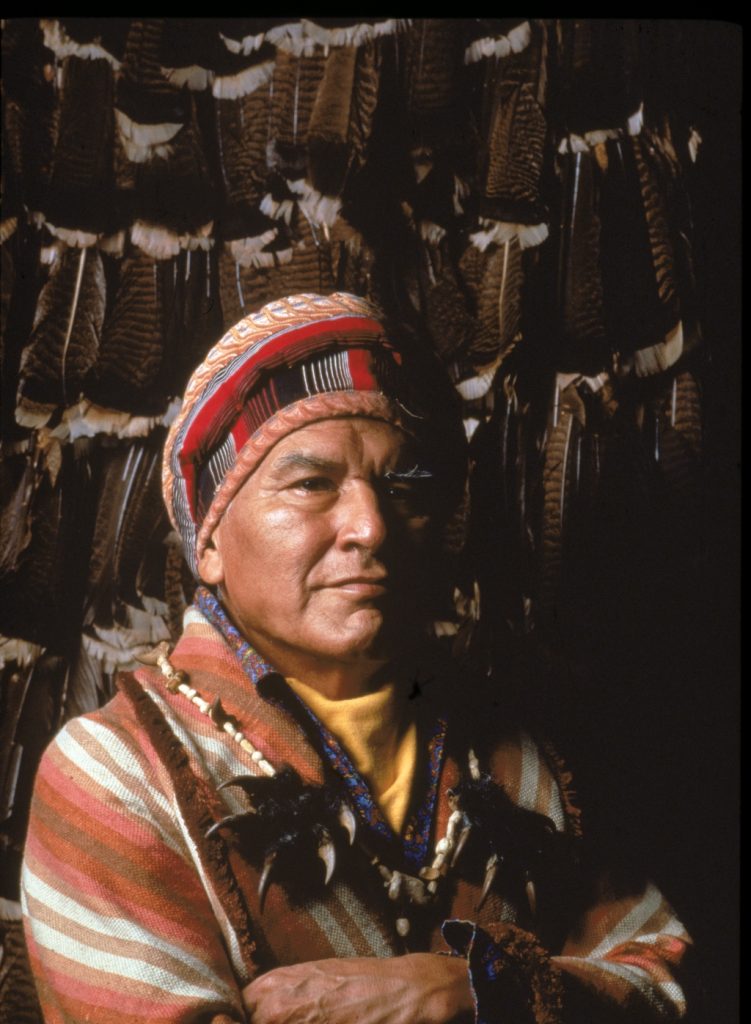The Stephen Beauregard Weeks Papers, 1746-1941 (collection #00762) is composed of correspondence, diaries, notebooks/logs, and other volumes related primarily to the history of southern education and religion. Documents cover a wide array of subjects, such as southern Quakers and slavery, the Methodist church in North Carolina and the South, 18th century Moravians in North Carolina, and the formation of the Southern Historical Association.
The collection’s creator, Stephen B. Weeks (1865-1918), was a white North Carolina educator and historian who at the beginning of the 20th century also worked as the superintendent of the San Carlos Boarding School for Apache Indians in Arizona. Coverage of his time and role there largely consists of correspondence between 1899 and 1907. These letters illuminate valuable biographical information about Apache students and their families, as well as provide contextual insight into the nature of other Native American boarding schools at the time.
The Bureau of Indian Affairs, an agency of the Department of the Interior, first initiated their paternalistic campaign for assimilation-through-education in the 1870s. Boarding schools operated both on and off reservations, but each generally shaped its policies and practices from Pennsylvania’s Carlisle Indian Industrial School’s (1879-1918) model. This institution’s guiding slogan was “To civilize the Indian, get him into civilization. To keep him civilized, let him stay” (Native Heritage Project, 2012). Government agents and educators believed it to be in the best interest of Indigenous peoples to “advance” through Americanization, and from this understanding developed an oppressive educational system which forcibly removed them from their families—sometimes as young as five-years-old. These schools then sought to strip Indigenous students of their native identities and culture. A framework as such did not tolerate students’ remnant adherence to Indigenous language, religion, and/or other customs. Failure to comply was often severely punished in the form of physical and emotional abuse. Beatings, labor, confinement, as well as sexual abuse, malnutrition, and disease were common experiences among students.
Below are two photos courtesy of the Cumberland County Historical Society. They capture Carlisle’s mission to replace Indigenous culture and their precedential setting for successive boarding schools with parallel ideologies. Visit the Cumberland Historical Society’s digital collection of more than 3,000 related images for larger views.
Of particular note regarding the series of letters uncovered from the Southern Historical Society’s collection is evidence of an imposed coding system used to identify students. These tag bands, as they were called, were placeholders in the forced transition from Apache to English names. They appear throughout Stephen B. Weeks’ correspondence in various combinations of letters and numbers, such as TE 18, SB 55, and CJ 18 (see Box 17). Government agents instigated this tag band system first by dividing the Apache population into bands—each allocated with a corresponding letter—and from there assigned individuals (married men first) an identifying number.
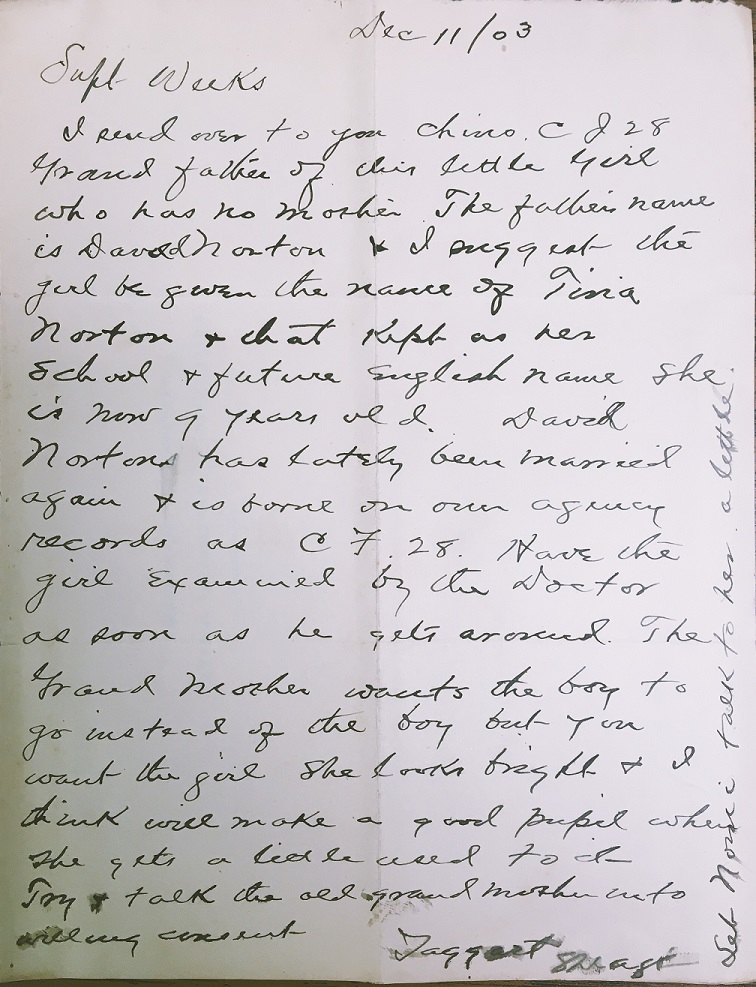
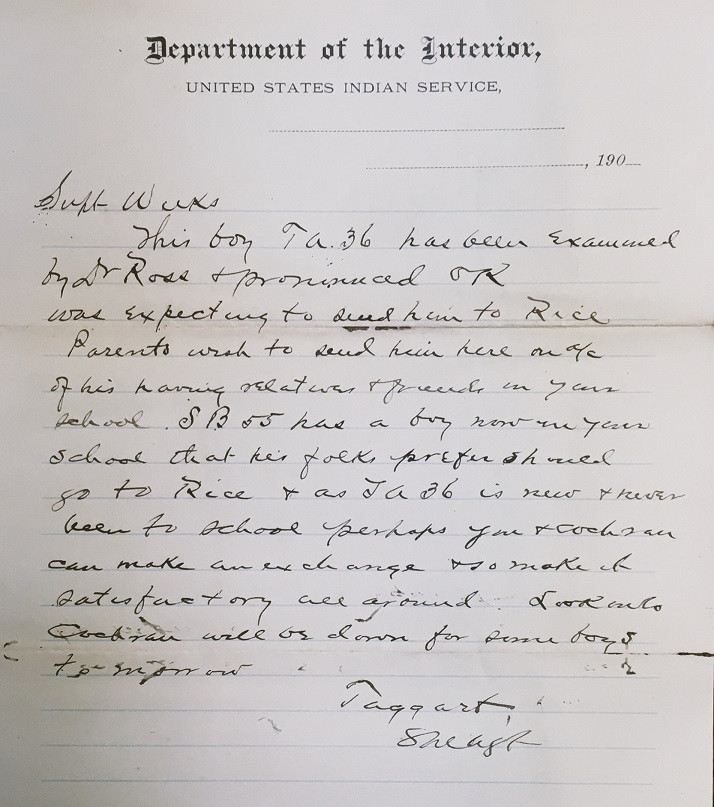
It’s important to note that this arbitrary system not only undermined Indigenous practices, autonomy, and decision-making, but also inflicted profound emotional harm on students and other Apaches subjected to it.
Keith H. Basso (1940-2013), a notable linguistic anthropologist, focused his research on the Apache people and has many publications which discuss these findings. In his collection of essays Western Apache Language and Culture (1992), Basso frames language as “everywhere a symbolic form without parallel or peer” and posits that “the activity of speaking—of enacting and implementing language—is surely among the most-meaning filled of all” (p. xii). Language is core to one’s identity, both individually and collectively as a people. To remove and replace it with something foreign is to severely deconstruct the person.
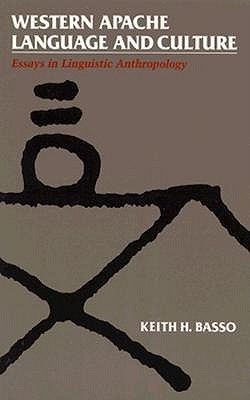
Basso goes on to explain that central to Apache language in particular is its significance of placenames—a value transferrable to the significance of more generalized proper nouns. Apaches intimately relate to their environmental landscape, geographic locations often holding noteworthy power in the exchange of stories and resulting sociocultural understandings about the world. These placenames facilitate tribal morality and standards of social interaction. Basso elaborates, “the character of these meanings—their steadier themes, their recurrent tonalities, and, above all, their conventionalized modes of expression—will bear the stamp of a common cast of mind. Constructions of reality that reflect conceptions of reality itself, the meanings of landscapes and acts of speech are personalized manifestations of a shared perspective on the human condition” (p. 140).
From this groundwork, Basso extrapolates that Apache placenames set precedent for the weight of other proper nouns, such as individuals’ names. Outsiders’ neglect of this Apache reality is rooted in an uninformed and over-simplified “view of language in which proper names are assumed to have meaning solely in their capacity to refer […] as agents of reference” (p. 143). Apache students with tag bands and, later, English names were primed for total loss of their native heritage with the initial loss of their native names.
Powerful insight from an Apache woman, known as Mrs. Annie Peaches and who was Basso’s first Apache teacher in 1959, further conveys this tragedy. She observes that “If we lose our language, we lose our breath. Then we will die and blow away like leaves” (p. xiii-xiv).
This collection’s listings of tag band identifiers, as well as Apache students’ English names, provide exciting new pathways into genealogical research and promote discussion about the detrimental effects of deracination practices imposed on Indigenous peoples nationwide. Note that findings listed from Box 17 (see above) may not be a comprehensive account, so we invite you to look through other boxes in the series for even more information on early 20th century Apache students at the San Carlos Boarding School. You can access the Finding Aid for the Stephen Beauregard Weeks Papers, 1746-1941 through this link https://finding-aids.lib.unc.edu/00762/ or visit the Research Room at Wilson Special Collections Library for in-person access to its abundant correspondence.
Additionally, listed below are several links to related collections from the National Archives and Records Administration which provide avenues to supplementary research, as well as resources for more contextual information about the Bureau of Indian Affairs’ boarding schools and Kevin H. Basso’s book on the Apache language. Finally, linked at the bottom is information about a Minneapolis based nonprofit working to collect and connect digitally dispersed Native American boarding school records. Please check out their website below for more information about how to help with this initiative.
Resources/references:
- A listing of NARA records from schools operated by the Bureau of Indian Affairs, nationwide
- NARA records related to the Fort Apache Indian Agency, which encompasses the San Carlos Boarding School
- NARA American Indian records on microfilm, categorized by tribe
- An explanation of allotment records and their value in biographical research
- The Power of American Indian Boarding School Records, a blog post of the National Archives and Records Administration
- Carlisle Indian School Records, a blog post of the Native Heritage Project
- An academic article with insight into the effects of the tag band system (pages 254-255):
Cornell, S., & Gil-Swedberg, M. C. (1995). Sociohistorical Factors in Institutional Efficacy: Economic Development in Three American Indian Cases. Economic Development and Cultural Change, 43(2), 239–268. doi: 10.1086/452149 - Basso, K. H. (1992). Western Apache Language and Culture: Essays in Linguistic Anthropology. Tucson: Univ. of Arizona Press.
- The National Native American Boarding School Healing Coalition’s website

